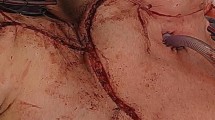Abstract
The aim of this paper was to determine if the subclavicular route of rotation improved the pectoralis major myocutaneous flap’s ability to reach head and neck sites in comparison to the traditional supraclavicular rotation. We dissected 50 flaps in 25 fresh adult male cadavers. The length of the pedicle and the flap’s ability to reach five anatomical head and neck sites (laryngeal prominence of thyroid cartilage, mentum, angle of the mandible, external auditory canal, and orbit) were tested by supraclavicular and subclavicular rotation. Although the average length of the flap’s pedicle was higher when the subclavicular rotation was employed, there was no statistical difference between the two techniques concerning the flap’s ability to reach the studied sites. Our results suggest that the subclavicular route apparently adds little to the reconstruction of head and neck defects using the pectoralis major myocutaneous flap. We believe that the indication of this technique should be evaluated on a case-by-case basis before it is recommended to keep from unnecessarily increasing the potential morbidity of the reparative procedure.




Similar content being viewed by others
References
Ariyan S (1979) The pectoralis major myocutaneous flap. A versatile flap for reconstruction in the head and neck. Plast Reconstr Surg 63(1):73–81
Freeman MS, Thomas JR, Zipper JA (1989) Clavicular division technique. A new approach for lengthening the pectoralis flap. Arch Otolaryngol Head Neck Surg 115(2):224–227
Kerawala CJ, Sun J, Zhang ZY, Guoyu Z (2001) The pectoralis major myocutaneous flap: is the subclavicular route safe? Head Neck 23(10):879–884
Chaturvedi P, Pathak KA, Pai PS, Chaukar DA, Deshpande MS, D’Cruz AK (2004) A novel technique of raising a pectoralis major myocutaneous flap through the skin paddle incision alone. J Surg Oncol 86(2):105–106
Qureshi SS, Chaukar D, Dcruz AK (2005) A simple technique of raising the pectoralis major myocutaneous flap along the deltopectoral groove. J Surg Oncol 89(1):32–33
Hoffmann TK, Balló H, Hauser U, Bier H (2006) The subclavicular route for the pectoralis major myocutaneous flap. HNO 54(7):523–527
Coruh A (2006) Pectoralis major musculocutaneous flap with nipple–areola complex in head and neck reconstruction: preliminary results of a new modified method. Ann Plast Surg 56(4):413–417
Rikimaru H, Kiyokawa K, Watanabe K, Koga N, Nishi Y, Sakamoto A (2009) New method of preparing a pectoralis major myocutaneous flap with a skin paddle that includes the third intercostal perforating branch of the internal thoracic artery. Plast Reconstr Surg 123(4):1220–1228
de Azevedo JF (1986) Modified pectoralis major myocutaneous flap with partial preservation of the muscle: a study of 55 cases. Head Neck Surg 8(5):327–331
Wilson J, Yiacaimettis A, O’Neill T (1994) Some observations on 112 pectoralis major myocutaneous flaps. Am J Surg 147:273–279
Vartanian JG, Carvalho AL, Carvalho MT, Mizobe L, Magrin J, Kowalski LP (2004) Pectoralis major and other myofascial/myocutaneous flaps in head and neck cancer reconstruction: experience with 437 cases at a single institution. Head Neck 26:1018–1023
Rikimaru H, Kiyokawa K, Inoue Y, Tai Y (2005) Three-dimensional anatomical vascular distribution in the pectoralis major myocutaneous flap. Plast Reconstr Surg 115(5):1342–1352
Daniel MM, Lorenzi MC, da Costa Leite C, Lorenzi-Filho G (2007) Pharyngeal dimensions in healthy men and women. Clinics 62(1):5–10
Ariyan S (1979) Further experiences with the pectoralis major myocutaneous flap for immediate repair of defects from excisions of head and neck cancers. Plast Reconstr Surg 64(5):605–612
Freeman JL, Walker EP, Wilson JSP, Shaw HJ (1981) The vascular anatomy of the pectoralis major myocutaneous flap. Br J Plast Surg 34:3–10
Milenović A, Virag M, Uglesić V, Aljinović-Ratković N (2006) The pectoralis major flap in head and neck reconstruction: first 500 patients. J Craniomaxillofac Surg 34(6):340–343
Park HD, Min YS, Kwak HH, Youn KH, Lee EW, Kim HJ (2004) Anatomical study concerning the origin and course of the pectoral branch of the thoracoacromial trunk for the pectoralis major flap. Surg Radiolol Anat 26(6):428–432
Conflict of interest statement
The authors declare that they have no conflict of interest with any financial support or any commercial source that may, directly or indirectly, interfere with the results reported on the present article.
Author information
Authors and Affiliations
Corresponding author
Rights and permissions
About this article
Cite this article
Vanni, C.M.R.S., Pinto, F.R., de Matos, L.L. et al. The subclavicular versus the supraclavicular route for pectoralis major myocutaneous flap: a cadaveric anatomic study. Eur Arch Otorhinolaryngol 267, 1141–1146 (2010). https://doi.org/10.1007/s00405-010-1203-5
Received:
Accepted:
Published:
Issue Date:
DOI: https://doi.org/10.1007/s00405-010-1203-5




